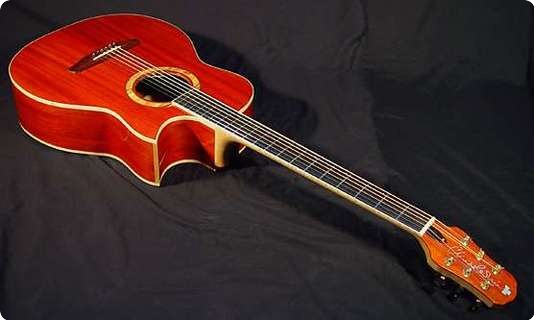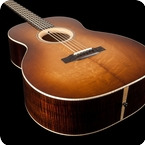Chris Larkin / TVR Baritone / 2014 / High Gloss / Guitar
The concept of the baritone guitar has been around for a while and has recently had a bit of a revival both with acoustic and electric guitars. What is a baritone? It is quite similar to a normal acoustic guitar but usually tuned a fifth or more below concert pitch - often BEADF#B or ADGCEA. If you tuned a regular acoustic guitar down this low the chances are that the strings would be so slack that it would be unplayable and, at that tension, the tone would be dreadful as the top would not work correctly. So for an effective baritone you need to extend the scale and use thicker strings. The scale length on the TVR Baritone (named after Tim van Roy who ordered this one from me) is 730mm (28.75") a full 80mm (3.15") longer than standard. This extra length allows for the strings to be at a higher tension and so to produce maximum response from the body. The strings (specially made by Malcolm Newton at Newtone Strings) run from 0.016 to 0.074 and exert more stress on the top than a normal guitar could take so the bracing has to be reinforced - in my case I use a double X bracing. You might wonder why go to all this trouble? Once you play a baritone you will understand. Initially it sounds strange as it is so much deeper than a regular guitar but very soon you get to appreciate the wonderful resonances, richness, and overtones that this tuning produces and you find yourself doing things that don't occur to you on a regular tuning, and particularly for me, simple chord sequences become mesmeric. I have read somewhere that this is the way an acoustic guitar is supposed to sound and that the regular item is too highly strung! This guitar also sustains like no other. You have to try it.
This TVR Baritone body (based on an ASAPJ model) is all Khaya mahogany (top, back and sides) with the wood taken from the same board. A red mahogany tint is added to the high gloss finish to add richness to the colour. Bracing is scalloped spruce a little heavier than normal. The silk finished neck is mainly maple but with a centre lamination of mahogany and the fingerboard is ebony. A solid wood rosette of spalted beech and figured maple bindings complete the woodwork. A Highlander IP-2 undersaddle piezo provides the main pickup with a Highlander condenser mic mounted internally on a miniature gooseneck to add as much or as little as the player wants. I fitted Schaller Vintage M6 tuning machines as the lower gearing of these helps with tuning the higher tension strings.
Soundwise it is amazingly crisp in the bass and soft in the trebles with a balanced midrange. It projects remarkably well. Not an instrument for the limp wristed as the higher tension on the strings requires extra pressure and accuracy when fretting (neither of which I have!). Worth the effort though. I look forward to hearing this recorded.
Price is exclusive of applicable tax/duties (VAT)
Chris Larkin Custom Guitars, Ireland 
About Chris Larkin
I work alone hand building a variety of instruments beside the beach on the beautiful west coast of Ireland. I am in my third decade of guitar making and it is still the best job in the world. And, so far, I get paid to do it. Nothing could be better!
Working alone gives me total control over the process. I do everything from buying in the wood to packing the instruments for shipping and nothing leaves the workshop that I cannot be proud of. Each day I look forward to going to work and learn something more about my craft. The more I learn the more I know I have to learn. And there is no Holy Grail in guitarmaking, there are too many variables in hand making an instrument to be sure of anything. The traditional 'rules' are there to be tested. At this stage, working with wood has become largely intuitive for me. And I am a wood junkie!
The wood junkie on the left is cuddling enough yellow cedar to make at least 40 flat top guitars when he cuts it up. This yellow cedar board is perfectly quartersawn with 80 grain lines per inch (31 per cm). Yellow cedar makes great archtops (jazzers and mandolins) and is also very good for steelstrings. In my opinion more people should try it.
The man on the right is taking instruction from Melody (the guitar building dog and real brains behind the business) on the best way to carve the top plate for an ASAS Semi. (yes Harvey, it is yours!)
I produce a limited number of master grade instruments each year almost all of which are exported (thanks to contacts made by exhibiting at the Frankfurt Musikmesse since 1985). Naturally I use the finest available materials. My designs are original, practical and, I think, beautiful. My instruments are individual for individuals.
My wife Syra is a professional painter (there she is on the left working on a portrait of Robbie Overson which was used for his album cover) and after years of makeshift workshops and studio space we finally designed and built our ideal workplace attached to our house in 1997. Syra has most of the upstairs with great natural light and wonderful views over the bays and mountains while I have the ground floor and an upstairs sprayroom. All of my areas are humidity controlled (47% RH) which gives me great confidence in dealing with the wood and the assurance that the possibilities of future climatic damage to instruments is limited to extreme conditions (which instruments should never be exposed to anyway!).
Ordering.
It is possible to order from a dealer or directly from me at the workshop. When a customer makes an order they will fill in a Conspec which is a document that specifies all aspects of the intended instrument. The Conspec is exchanged between me and the customer being changed by agreement until we are both happy with what is to be made. At this stage a firm price and delivery date is set. The Conspec now becomes the blueprint from which I will work when I am making the instrument. The Conspec can be changed at any time up until the start of building with agreement between the customer and me. As both the customer and builder have a copy of the Conspec there should be no surprises on delivery! Payment.
For orders from the workshop a non-returnable deposit of 30% is normally paid when the Conspec is agreed and the price is set. The balance is payable on completion of the instrument. A photograph of the finished instrument is sent to the customer (by mail or email) to show that the building is complete and shipping happens when the balance of the money reaches my bank.
For orders from dealers the payment details should be arranged with the dealer concerned.
Shipping.
Shipping costs are the responsibility of the customer. For orders from the workshop I can arrange shipping by insured courier at cost if required.
Taxes.
Someone once said that the only two things you can be sure about in life are taxes and death! I can tell you a bit about the taxes.
Orders from the workshop that are to countries within the European Union to persons who are not registered for VAT will have Irish VAT included in the price at the rate that is current at the time of payment. Orders outside the European Union will be free of Irish taxes but note that most governments charge some sort of tax on imported instruments. Check what this will be locally. Orders from dealers will include whatever taxes are relevant in that country.Your dealer can tell you about this.



